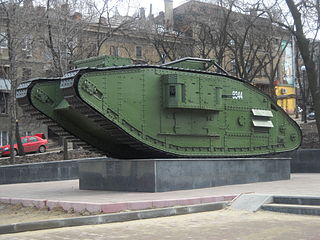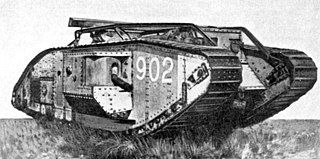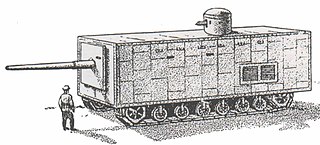
The Infantry Tank Mark II, best known as the Matilda, was a British infantry tank of the Second World War.

The history of the tank begins with World War I, when armoured all-terrain fighting vehicles were introduced as a response to the problems of trench warfare, ushering in a new era of mechanized warfare. Though initially crude and unreliable, tanks eventually became a mainstay of ground armies. By World War II, tank design had advanced significantly, and tanks were used in quantity in all land theatres of the war. The Cold War saw the rise of modern tank doctrine and the rise of the general-purpose main battle tank. The tank still provides the backbone to land combat operations in the 21st century.

The Tank, Infantry, Mk IV (A22) Churchill was a British infantry tank used in the Second World War, best known for its heavy armour, large longitudinal chassis with all-around tracks with multiple bogies, its ability to climb steep slopes, and its use as the basis of many specialist vehicles. It was one of the heaviest Allied tanks of the war.

Crusader, in full "Tank, Cruiser Mk VI, Crusader", also known by its General Staff number A.15, was one of the primary British cruiser tanks during the early part of the Second World War. Over 5,000 tanks were manufactured and they made important contributions to the British victories during the North African campaign. The Crusader tank would not see active service beyond Africa but the chassis of the tank was modified to create anti-aircraft, fire support, observation, communication, bulldozer and recovery vehicle variants.

The Tank, Cruiser, Challenger (A30) was a British tank of World War II. It mounted the QF 17-pounder anti-tank gun on a chassis derived from the Cromwell tank to add anti-tank firepower to the cruiser tank units. The design compromises made in fitting the large gun onto the Cromwell chassis resulted in a tank with a powerful weapon and reduced armour. The extemporised 17-pounder Sherman Firefly conversion of the US-supplied Sherman was easier to produce and, with delays in production, only 200 Challengers were built. The Challenger was able to keep up with the fast Cromwell tank and was used with them.

The infantry tank was a concept developed by the United Kingdom and France in the years leading up to World War II. Infantry tanks were designed to support infantrymen in an attack. To achieve this, the vehicles were generally heavily armoured to allow them to operate in close concert with infantry even under heavy fire. The extra armour came at the expense of speed, which was not an issue when supporting relatively slow-moving foot soldiers.

British heavy tanks were a series of related armoured fighting vehicles developed by the UK during the First World War. The Mark I was the world's first tank, a tracked, armed, and armoured vehicle, to enter combat. The name "tank" was initially a code name to maintain secrecy and disguise its true purpose by making it appear to be a water transport vehicle for bringing water to the troops at the front line. The tank was developed in 1915 to break the stalemate of trench warfare. It could survive the machine gun and small-arms fire in "no man's land", travel over difficult terrain, crush barbed wire, and cross trenches to assault fortified enemy positions with powerful armament. Tanks also carried supplies and troops.

The Mark VI was a British heavy tank project from the First World War.

The Gun Carrier Mark I was a British vehicle of the First World War. The gun carrier was designed to transport a 6-inch howitzer or a 60-pounder gun forward soon after an attack to support infantry in advanced positions. Gun carriers were first used in the Battle of Pilckem Ridge during the Third Battle of Ypres. The carriers moved guns and equipment but were used for the rest of the war mainly for carrying equipment and supplies through areas under fire, where porters in the open would have suffered many casualties. The 6-inch howitzer could be fired while mounted, making the Gun Carrier Mark I the first modern self-propelled gun, a weapon capable of independent action and having tactical mobility on the battlefield.
The Tank, Heavy, TOG 1 was a prototype British super-heavy tank produced in the early part of the Second World War in the expectation that battlefields might end up like those of the First World War. It was designed so it could cross churned-up countryside and trenches. A single prototype was built, and followed by an improved model, but interest faded with the successful performance of another cross-country design, the Churchill tank, and the mobile war that was being fought.

The Mark VIII tank also known as the Liberty or The International was a British-American tank design of the First World War intended to overcome the limitations of the earlier British designs and be a collaborative effort to equip France, the UK and the US with a single heavy tank design.

The "Female" tank was a variation of the British heavy tank deployed during the First World War. It carried multiple machine guns instead of the mix of machine guns and cannons mounted on the "male" tank. Lieutenant-Colonel Ernest Swinton, who played a part in the development of the first British tank and who was co-creator of the term "tank", is credited with inventing these gender-related terms, thinking that the best tank tactics would have the two types operating in concert.

The development of tanks in World War I was a response to the stalemate that developed on the Western Front. Although vehicles that incorporated the basic principles of the tank had been projected in the decade or so before the War, it was the alarmingly heavy casualties of the start of its trench warfare that stimulated development. Research took place in both Great Britain and France, with Germany only belatedly following the Allies' lead.

Little Willie was a prototype in the development of the British Mark I tank. Constructed in the autumn of 1915 at the behest of the Landship Committee, it was the first completed tank prototype in history. Little Willie is the oldest surviving individual tank, and is preserved as one of the most famous pieces in the collection of The Tank Museum, Bovington, England.

The British Mark V tank was an upgraded version of the Mark IV tank.

The Mark IV was a British tank of the First World War. Introduced in 1917, it benefited from significant developments of the Mark I tank. The main improvements were in armour, the re-siting of the fuel tank and ease of transport. A total of 1,220 Mk IV were built: 420 "Males", 595 "Females" and 205 Tank Tenders, which made it the most numerous British tank of the war. The Mark IV was first used in mid 1917 at the Battle of Messines Ridge. It remained in British service until the end of the war, and a small number served briefly with other combatants afterwards.

This article on military tanks deals with the history and development of tanks of the British Army from their first use in the First World War, the interwar period, during the Second World War, the Cold War and modern era.

The Mendeleev Tank was a proposed early tank design by Russian naval engineer Vasiliy Mendeleev, son of Russian scientist Dimitri Mendeleev, who created the modern periodic table. The vehicle was envisioned by Mendeleev during his time working at the Kronshtadt Marine Engineering School in Saint Petersburg, Russia, from 1911 to 1915. Its purported purpose was to be a "landship" immune to all enemy fire and able to cross large battlefields while providing heavy artillery support to troops using a 120 mm gun. The proposed tank was one of the heaviest tank designs of all time; at 173.2 tons it would have been nearly the same weight as the World War II German Panzer VIII Maus superheavy tank.
Group Captain Thomas Gerard Hetherington CBE was a British officer who served in the British Army, Royal Navy and Royal Air Force. He was one of those credited with the initial development of the tank during the early part of the First World War. Although his design for an enormous wheeled vehicle proved to be impractical, it earned him a seat on the Landship Committee and he participated in early experiments with tracked vehicles.


















